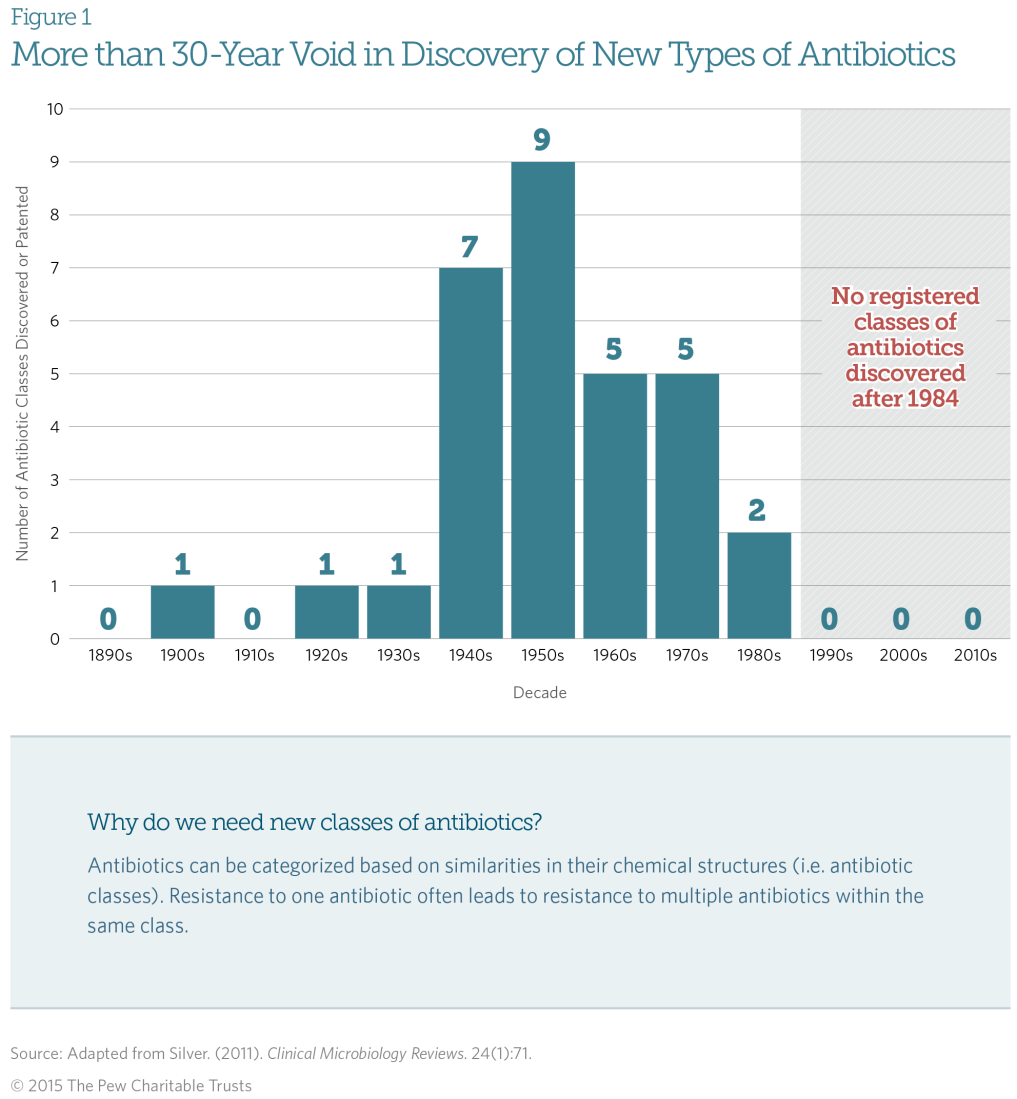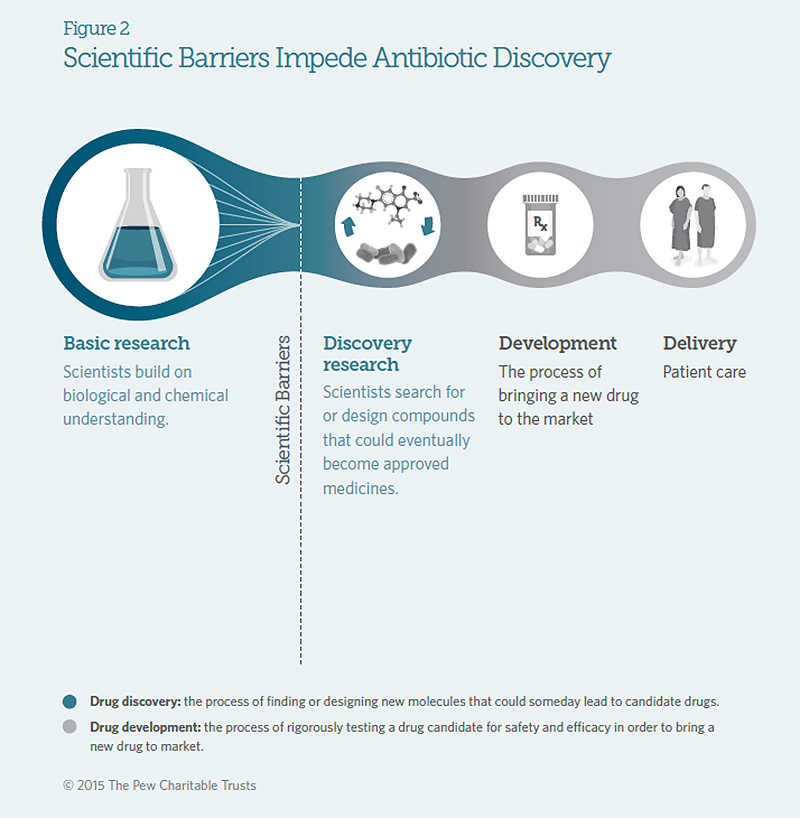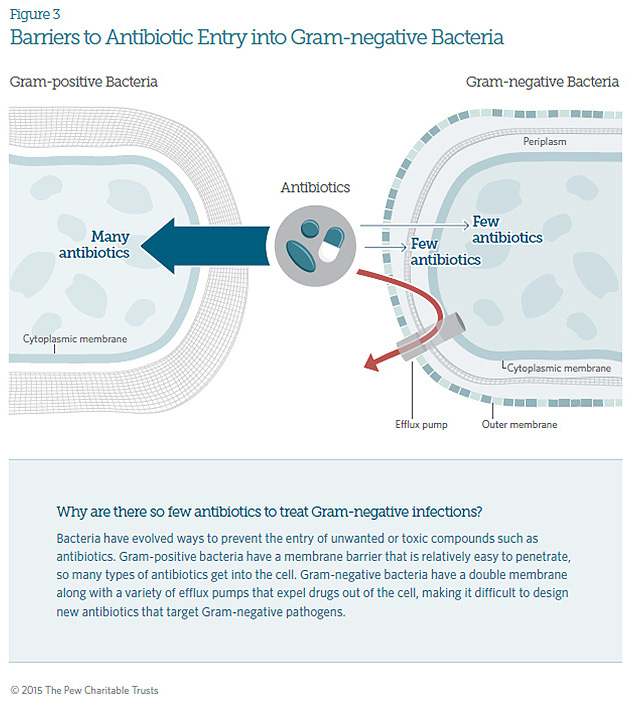A Scientific Roadmap for Antibiotic Discovery
A sustained and robust pipeline of new antibacterial drugs and therapies is critical to preserve public health
Overview
Every year, more than 2 million people in the United States contract a drug-resistant bacterial infection, and 23,000 die as a result. Yet, there are too few new antibiotics in development to meet patient needs. Underpinning the problem are fundamental gaps in scientific research that hinder drug discovery.
State of the field
Antibiotic discovery peaked in the 1950s, but then dropped precipitously from the 1980s onward. (See Figure 1.1) Every antibiotic in clinical use today is based on a discovery made more than 30 years ago.2

Most large pharmaceutical companies are no longer actively searching for new antibiotics. Neither the small companies that continue to develop new drugs nor the academic researchers focused on this problem are well positioned to tackle the scientific challenges facing the field as a whole. (See Figure 2.)

Scientific barriers to antibiotic discovery
There are three key scientific barriers to the discovery of new antibiotics and the advancement of novel therapies.
The first is the need to overcome the multiple defenses of drug-resistant Gram-negative pathogens, bacteria which cause some of the most deadly infections.3 Gram-negative bacteria have two membranes and protein “pumps” that actively expel drugs from the cell—built-in defense mechanisms against many antibiotics. (See Figure 3.) This is only one of the critical challenges that scientists must address to better find and design starting points for new drugs.
Second, of the millions of molecules available in existing chemical collections, few have the properties needed to enter and stay inside Gram-negative bacteria; finding a molecule that may lead to a potential antibiotic is astonishingly difficult. To increase the odds of success, scientists need to experiment to figure out what types of molecules can get into the bacterial cell and which cannot, in order to create guidelines for finding the molecules that work. This would allow for the creation of collections of promising molecules that researchers everywhere could use to more effectively search for new antibiotics.
Finally, entirely new approaches to treating infections must be studied. Biologics, immunotherapies, and anti-virulence therapies have shown promise as alternatives to traditional antibiotic therapy. But there is a need for more standard tools with which to assess these methods, such as new proof-of-concept studies and experimental models to predict whether these novel approaches might work in the clinic.

Pew’s roadmap for antibiotic discovery
To overcome the barriers to antibiotic discovery, The Pew Charitable Trusts has proposed a strategy to fund research tackling the key questions outlined above. It draws on input from leading antibiotic discovery experts in industry, academia, government, and the nonprofit sectors.
In addition, the roadmap highlights growing concern that valuable institutional knowledge and expertise are at risk of being lost as industry teams are downsized or shuttered, and antibiotic scientists retire or shift to different biomedical areas. Collating the existing body of research, and making it available to scientists who need this information, would promote knowledge-sharing and help reinvigorate the research landscape.
Pew’s Scientific Roadmap for Antibiotic Discovery seeks to build a sustainable and robust foundation for the discovery of new antibiotics over the decades to come. The roadmap recognizes the need for full-time scientific leadership and identifies a concrete, targeted approach to tackle the basic scientific barriers impeding antibiotic discovery—which includes better understanding how to overcome the defenses of Gram-negative bacteria, developing tools and technologies for scientists to generate new molecules tailored for antibiotic discovery, evaluating promising alternatives to traditional antibiotic use, and establishing a framework for sharing information, expertise, and materials across the antibiotic research community. These are critical next steps to fostering innovation and spurring the discovery of new antibiotics.
Endnotes
- Source: Adapted from Lynn L. Silver, "Challenges of Antibacterial Discovery," Clinical Microbiology Reviews 24, no. 1 (2011): 71–109, doi: 10.1128/CMR.00030-10.
- Cynthia C. Knapp and John A. Washington, “Antistaphylococcal Activity of a Cyclic Peptide, LY146032, and Vancomycin,” Antimicrobial Agents and Chemotherapy 30, no. 6 (1986): 938–39, doi:10.1128/AAC.30.6.938.
- U.S. Centers for Disease Control and Prevention, Antibiotic Resistance Threats in the United States, 2013 (2013), http://www.cdc.gov/drugresistance/pdf/ar-threats-2013-508.pdf.


This video is hosted by YouTube. In order to view it, you must consent to the use of “Marketing Cookies” by updating your preferences in the Cookie Settings link below. View on YouTube
This video is hosted by YouTube. In order to view it, you must consent to the use of “Marketing Cookies” by updating your preferences in the Cookie Settings link below. View on YouTube


A Scientific Roadmap for Antibiotics
A sustained and robust pipeline of new antibacterial drugs and therapies is critical to preserve public health






